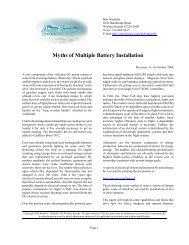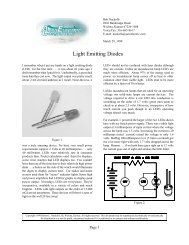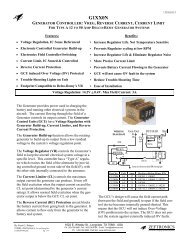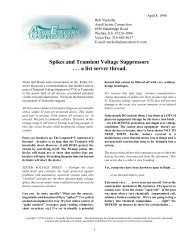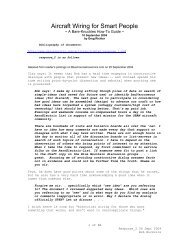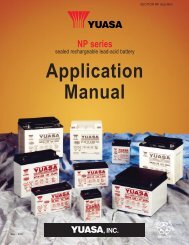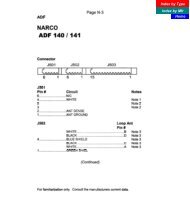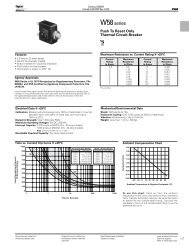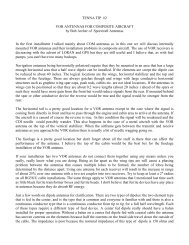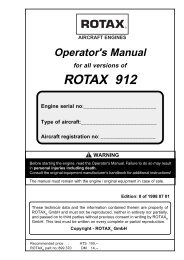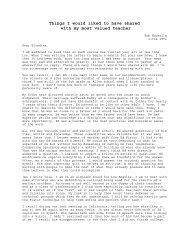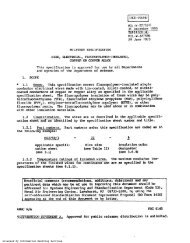ATSO document version 1 - AeroElectric Connection
ATSO document version 1 - AeroElectric Connection
ATSO document version 1 - AeroElectric Connection
You also want an ePaper? Increase the reach of your titles
YUMPU automatically turns print PDFs into web optimized ePapers that Google loves.
Microair Avionics Pty LtdAirport DriveBundabergQueensland 4670AustraliaTel: +61 7 41 553048Fax: +61 7 41 553049e-mail: support@microair.com.au
Microair Avionic T2000 Transponder User ManualAbout This DocumentMicroair Avionics have developed a series of transponders for use withOEM applications, and for commercial sale by Microair Avionics. Themanual explains the basic functions and elaborates on the moresophisticated features, such as altitude display and alerts.Revision 2.7 of this manual is to be supplied and used in conjunction withT2000SFL transponders with software <strong>version</strong> 1.6.3, or later.Microair reserves the right to amend this manual as required, to reflect anyenhancements or upgrades to the T2000 Transponder series.© Microair Avionics Pty LtdStatement:The T2000SFL owner accepts all responsibility for obtaining the proper licensing before using the transponder. The coverage you canexpect from the T2000SFL is limited to “line of sight”. Low altitude or aircraft antenna shielding by the aircraft itself may result in areduced range. Range can be improved by climbing to a higher altitude. It may be possible to minimize antenna shielding by locating theantenna where dead spots are only noticed during abnormal flight attitudes.The T2000SFL should be turned off before starting or shutting down aircraft engine(s).MICROAIR DOCUMENTSMicroair T2000 Users ManualMicroair T2000 Installation ManualMicroair T2000 Flight Manual SupplementMicroair T2000 Service ManualMicroair T2000 User Manual Supplement (use with user manual 2.5)T2000-DOC-001T2000-DOC-002T2000-DOC-003T2000-DOC-004T2000-DOC-005DOCUMENT REVISION STATUS – T2000-DOC-001Revision Date Change1.0 11/02/01 Initial Draft2.2 11/07/01 Voltage Monitoring2.3 22/08/01 Standby function added2.4 05/10/01 Hi / Lo alerts added2.5 12/10/01 Mode and Program Mode menu functions amended2.6 07/11/01 Deleted SF references2.7 01/06/02 Assigned Alt & Buffer Alt input amended, Name/Reg relocated to end of Program ModeVersion 2.7 Page 2 1 st June 2002
Microair Avionic T2000 Transponder User ManualTABLE OF CONTENTSINTRODUCTION............................................................................................................. 4T2000 CONTROLS ................................................................................................................................... 6TURNING ON ........................................................................................................................................... 6BACKLIGHTING..................................................................................................................................... 6TURNING OFF ......................................................................................................................................... 6TRANSPONDER OPERATION.............................................................................................................. 7DISPLAY LAYOUT ....................................................................................................................................................... 7DISPLAY FUNCTION..................................................................................................... 8CONTROL FUNCTIONS................................................................................................ 9SELECTMODE KNOB ............................................................................................................................ 9CODE SELECT KNOB .......................................................................................................................... 10ON KEY ................................................................................................................................................... 10MODE KEY............................................................................................................................................. 11QNH OR BARO (BAROMETRIC PRESSURE).......................................................................................................... 12ASSIGNED (ALTITUDE) ........................................................................................................................................... 13BUFFER ALT.............................................................................................................................................................. 13ALTITUDE (UNITS) ................................................................................................................................................... 15VOLTAGE ................................................................................................................................................................... 16ALERT TONE.............................................................................................................................................................. 17ENTER KEY............................................................................................................................................ 18TOGGLE KEY ........................................................................................................................................ 18VFR – HOT KEY .................................................................................................................................... 19ID KEY..................................................................................................................................................... 19INITIALISATION AND SETUP .................................................................................. 20PROGRAM MODE................................................................................................................................. 20VOLT MON................................................................................................................................................................. 21A/C VOLT.................................................................................................................................................................... 21O/V SET....................................................................................................................................................................... 21U/V SET....................................................................................................................................................................... 22E/C POW..................................................................................................................................................................... 22VFR CODE ................................................................................................................................................................. 22BARO........................................................................................................................................................................... 23REM STBY................................................................................................................................................................... 23NAME /REG (ONE TIME ONLY ENTRY) ................................................................................................................. 24EXIT PROGRAM ........................................................................................................................................................ 24FREQUENTLY ASKED QUESTIONS: ...................................................................... 25Version 2.7 Page 3 1 st June 2002
Microair Avionic T2000 Transponder User ManualINTRODUCTIONThe Microair T2000 Transponder is designed to operate in the environment of a Radar Beacon System. Thissystem interrogates the transponder, which in turn replies with an identity code and altitude information. Theradar system consists of a network of ground stations, which sweep the horizon like a conventional radar. Whenthe transponder in the aircraft detects the radar sweep (is illuminated), the transponder replies with a bursttransmission giving its identity code and altitude.The aircraft’s transponderreceives the ground stationsignal asking it to transmit. Thetransponder “replies” with thecode, and if operating in modeC, the encoder altitude.Ground stations sweep the sky with a signal, whichasks the transponder in the aircraft to transmit itscode and altitude.The system presents the replies from all transponders in range of the ground stations on a single display screen.This allows ATC to easily locate, identify, and see the altitude of all traffic in their airspace.A transponder’s reply is termed a squawk. Hence the current code being used by the transponder is termed thesquawk code. At times of high airspace activity, ATC may wish to uniquely identify an individual aircraft with arequest to squawk ident. The pilot uses the ident control on the transponder to make the transponder’s squawk onthe ATC display flash for a short period. The ident control should not be used unless ATC request it.ATC will issue a code to an aircraft requesting entry into its controlled airspace. This code is normally uniquefor each aircraft, each time that aircraft passes through the airspace. The code is 4 digits long, and each digit canrange from 0-7.Version 2.7 Page 4 1 st June 2002
Microair Avionic T2000 Transponder User ManualThere are several special codes, which are used to identify General Aviation aircraft, and some special situationswhich aircraft could encounter. Misuse of these codes may result in legal charges against the user.IMPORTANT NOTEALWAYS check the standby code, BEFORE transferring it to the ACTIVEposition.0000 General Purpose code subject to regional agreement1200 Civil VFR Flights OCTA not participating in RadarInformation Service (RIS). General Aviation Code (US andother countries)2000 Civil IFR Fights OCTA not participating in RIS3000 Civil Flights in Controlled airspace7000 VFR General Aviation Code (Europe)7500 Unlawful Interference Code7600 Radio Communications Failure7700 Emergency Code7777 Military Intercept Code (NEVER USE)Code 2100 is a test code that can be used by qualified personal to test the transponder to ATC.The user should check the Civil Aviation Rules/Regulations to determine the VFR General Aviation transpondercode for their country.Version 2.7 Page 5 1 st June 2002
Microair Avionic T2000 Transponder User ManualT2000 CONTROLSAll of the T2000’s functions and features can be accessedfrom the controls on the front face.CONTROLDESCRIPTION1 ON Key2 MODE Key3 ENTER Key4 IDENT Key5 TOGGLE Key6 CODE SELECT Knob7 SELECTMODE Knob8 VFR KeyTURNING ONThe T2000 is turned on by pressing the ON key. The T2000 will gothrough a start up routine displaying self test messages, and endingwith the operational display. The backlighting is also tested duringstart up.ON KEYBACKLIGHTINGThe T2000SFL has an LCD display which is backlit. The backlighting has a low and a high brightness level toenhance the display in low light conditions, and darkness.When the T2000 is first turned on there is no backlighting.Press the ON key again – Low level Backlighting comes on.Press the ON key again – High level Backlighting comes on.Press the ON key again – Display returns to no backlightingTURNING OFFThe T2000 is turned off by holding down the ON Key. The wordSHUTDOWN is displayed and the T2000 counts down from 3-0,then turns off. If the ON Key is lifted before the count is finished, theT2000 returns to the operational screen.ON KEYVersion 2.7 Page 6 1 st June 2002
Microair Avionic T2000 Transponder User ManualCONTROL FUNCTIONSThis section describes the transponder control keys and their functions. Many of the control keys have morethan one function, and some keys access multi-option menus, which can be scrolled.SELECTMODE KNOBThe SELECTMODE knob allows the user to switch the transponderbetween the 4 operating modes.Selectmode KnobSTANDBYONALTIn standby the transponder is powered up, but will not transmit.On the active display line the letter S appears on the left hand side.Will reply to Mode A and C interrogations, but with no mode C encoder information. Mode C blindencoder is normally powered up in this mode, but can be powered down if encoder power option is setOFF (refer E/C POW in Initialisation and Setup section).On the active display line the letter A appears on the left hand side.Will reply to Mode A and C interrogations, with the mode C encoder information. In the absence of avalid encoder input, only the C framing pulse will be sent.On the active display line the letter C appears on the left hand side.ALT DISPLAY The standby code is replaced with the encoder altitude. If the pressure has been set via the QNH /Baro option of MODE MENU, the displayed altitude will be adjusted for barometric air pressure.Altitude will be displayed in units set in ALTITUDE option of MODE MENU.The DISPLAY ALT only displays altitude if a valid encoder input is being received. Whenclimbing above the transition level/layer, the user must reset the transponder at the same time as theaircraft’s altimeter to 1013mb or 29.92HG.On the active display line the letter C appears on the left hand side.Examples of encoder altitudeExamples of pressure adjusted encoder altitudeVersion 2.7 Page 9 1 st June 2002
Microair Avionic T2000 Transponder User ManualCODE SELECT KnobThe CODE SELECT knob can be rotated clockwise to scrollupwards, and counter-clockwise to scroll downwards. Each digit ofthe code is adjusted separately. The adjust function starts with the lefthand digit, and is moved across to the next digit by pushing theCODE SELECT knob inwards. After 10 seconds of inactivity thecursor will revert to the left hand digit.ON KEYRefer to TURNING ON section for basic operation.The ON key tuns on the T2000 and adjusts the back lighting.To turn off the T2000, the ON key is held down. The display countsdown from 3 to 0 then turns off.Code SelectOn KeyVersion 2.7 Page 10 1 st June 2002
Microair Avionic T2000 Transponder User ManualMODE KEYThe MODE key can be used to access two separate menus:Mode Key• If the transponder is turned on, by holding down the MODE key, and pressing the ON key, the T2000 willstart in PROGRAM MODE. The MODE key must be held down, until the start-up self-test messages havebeen displayed.• If the transponder is ON and in normal operation, press the MODE key to access the MODE MENU. Thefirst item of the MODE MENU is displayed. Step through the MODE MENU by pressing the MODE key.After the last menu item the T2000 returns to the operational display currently in use.The MODE MENU is designed to allow the operator fast easy access to functions and parameters, which mayneed to be adjusted in flight.MODE MENUQNH or BaroAssignedBuffer AltAltitudeVoltageAlert ToneUSE MODE KEY TO STEPTHROUGH OPTIONSORUSE THE Toggle KEY TORETURN TO THEOPERATIONAL DISPLAYVersion 2.7 Page 11 1 st June 2002
Microair Avionic T2000 Transponder User ManualQNH or BARO (Barometric Pressure)The altitude encoder outputs a pressure altitude fixed at an above mean sea level (AMSL) pressure of 1013mbor 29.92HG. The aircraft’s altimeter however is normally adjusted for actual surface pressure before take off.This means the encoder altitude may not be the same as the altimeter reading.The QNH / Baro can be entered here to allow the T2000 to compensate the displayed altitude for surfacepressure, and hence read the same as the aircraft’s altimeter. The default QNH is 1013mb or Baro is 29.92HG.If the QNH / Baro is set to 1013mb or 29.92HG, the altitude displayed will default to the unadjusted pressurealtitude direct from the encoder. If the QNH / Baro is set to a discrete value (normally provided by ATC), theencoder pressure altitude displayed will be adjusted for that QNH / Baro value.The barometric units are set in the BARO option of the PROGRAM MODE. When MB is selected the QNHscreen is displayed, and when HG is selected the Baro screen is displayed.Press MODE key (once)Rotate CODE SELECT knobPress ENTER keyPress toggle keyTo select QNH / Baro optionScroll lower line to desired pressure. Press knob to move one place to left.To set default value. The default is 1013(mb) or 29.92(HGDisplay returns to current operational displayIMPORTANT NOTEThe T2000 will only transmit the encoder pressure altitude. Theadjusted QNH / Baro altitude is NEVER transmitted, even when it isselected for display.Version 2.7 Page 12 1 st June 2002
Microair Avionic T2000 Transponder User ManualASSIGNED (altitude)The user can input an assigned altitude given by ATC. When used with the altitude buffer value, an audio alertand display indicator advises when the aircraft has climbed or descended, from the assigned altitude.When the Altitude option of the mode menu is set to Feet, theAssigned altitude is adjusted in feet.When the Altitude option of the mode menu is set to Flight Level,the Assigned altitude is adjusted in feet.When the Altitude option of the mode menu is set to Metres, theAssigned altitude is adjusted in Metres.Press MODE key (2 times) To select Assigned optionPress CODE SELECT knob Increment displayed value in units of 500 feet / 100m / FL50Rotate CODE SELECT knob Increment displayed value in units of 100 feet / 10m / FL10Press ENTER key To set default value. The default is 0.Press toggle keyTo save and display returns to current operational displayWhen entering an altitude…Press the CODE SELECT knob to increase the height value in unitsof 500FT / 100M / FL50.Rotate the CODE SELECT knob to increase or decrease the heightvalue in units of 100FT / 10M / FL10.Press the ENTER key to return the ASSIGNED ALTITUDE to the default value of 0,Press the Toggle key to save the height value, and return to the operational display.orIf Assigned is set to 0, the altitude alert function is disabled. The assigned altitude function is only active whenthe SELECTMODE knob is set to DISP ALT.BUFFER ALTThe user can input a buffer altitude, above and below the assigned altitude, to define a height band in which tofly. When the aircraft exceeds the upper or lower limit, an indicator alert message will be displayed. The alertVersion 2.7 Page 13 1 st June 2002
Microair Avionic T2000 Transponder User Manualmessage advises the pilot of how far, above or below the assigned altitude the aircraft is. If the Alert Tonefunction is ON, an audio tone is heard as well.If the ALTITUDE option in the PROGRAM MODE is set to FEET or FL, the Buffer Alt increments are infeet. If ALTITUDE is set to METRES, the Buffer Alt increments are in metres.Press MODE key (3 times) To select Buffer Alt optionPress CODE SELECT knob Increment displayed value in units of 500 feet / 100m / FL50Rotate CODE SELECT knob Increment displayed value in units of 100 feet / 10m / FL10Press ENTER keyDisplay returns to current operational display (No default value)Press Toggle keyDisplay returns to current operational displayALTITUDE BUFFERALTITUDE BUFFERWith the Assigned altitude set at 3500 feet, and theBuffer Alt set at 200 feet, the display alerts willoccur over 3700 feet and under 3300 feet.ASSIGNED ALTITUDENo alert will be displayed while the aircraft remainsinside the 3700-3300 buffer.If the aircraft climbs or descends outside the altitude buffer limits, a Hi / Lo warning is displayed on the lowerline.T2000 advises the pilot that the aircraft is 500 feet abovethe Assigned altitude. If the Alert Tone function is set on,an audio warning tone is heard.T2000 advises the pilot that the aircraft is 500 feet belowthe Assigned altitude. If the Alert Tone function is set on,an audio warning tone is heard.Version 2.7 Page 14 1 st June 2002
Microair Avionic T2000 Transponder User ManualALTITUDE (units)The altitude data can be displayed as feet, flight level, or metres. Once the Altitude units are set, all altitude datais displayed in these units.The options are: F = FEET eg 15000FFL = FLIGHT LEVEL eg FL 150M = METRESeg 5000 MThe only exception is when the Altitude is set to FL, the Buffer Alt is still displayed and set in FEET.Press MODE key (4 times) To select Altitude optionRotate CODE SELECT knob Scroll to select desired units.Press ENTER keyNo operation. (No default value)Press toggle keyDisplay returns to current operational display5350 FEET. Units in feet are indicated by the F character at theright hand end of the lower display line. All altitude data will bedisplayed in feet.FLIGHT LEVEL 153. Units in Flight Levels are indicated by theFL characters preceding the number on the lower display line. Allaltitude data will be displayed in Flight Level, except for theBuffer Alt which is displayed in FEET.1500 METRES. Units in metres are indicated by the M characterat the right hand end of the lower display line. All altitude datawill be displayed in metres.IMPORTANT NOTEWhen operating in upper airspace it may be necessary to measure altitudein units of FLIGHT LEVEL instead of FEET. The T2000 allows the pilotto change altitude units (and change back), at any time during operation,via the ALTITUDE item of the MODE menu.Version 2.7 Page 15 1 st June 2002
Microair Avionic T2000 Transponder User ManualALERT TONEThe Alert Tone function is used by the T2000’s altitude alert function. When set ON, the Alert can be heardfrom either the cabin speaker, or through the headphones, when amplified through an audio panel. The beeptone is produced at a very low level, and cannot be heard directly with headphones or speaker.Press MODE key (6 times) To select Alert Tone optionRotate CODE SELECT knob Scroll lower line to select ON or OFF. The default is ONPress ENTER keyNo operationPress toggle keyDisplay returns to current operational displayIMPORTANT NOTEPressing the MODE key again returns the display to the operational screen.The user can press the toggle key at any point in the MODE menu to return tothe operational screen.Version 2.7 Page 17 1 st June 2002
Microair Avionic T2000 Transponder User ManualENTER KEYThe ENTER key is a confirmation key used to confirm information the user has inputted. After pressing theENTER key, the display will typically give the message SAVED, for a short period.The ENTER key is also used to quick-set a parameter to a default value.Enter KeyTOGGLE KEYThis key acts as a toggle switch, exchanging the active and standby codes.Toggle KeyWhen the transponder is operating in DISPLAY ALT the bottom line displays theencoder altitude instead of the standby code. The standby code is stored in memory.To toggle the active and standby codes in this mode, push the toggle key once todisplay the standby code on the bottom line. The standby code is displayed for 10seconds. Push the toggle key again to exchange the active and standby codes. Oncethe codes have been exchanged, the display will revert back after 10 seconds, todisplaying the altitude on the bottom line.In all modes of operation, only the active code is transmitted.The toggle key is also used to return to the operational screen from the MODE and PROGRAM MODEmenus.Version 2.7 Page 18 1 st June 2002
Microair Avionic T2000 Transponder User ManualVFR – HOT KEYThe VFR key will default the standby code immediately to the stored VFR code.Typically this code will be 1200 for a General Aviation aircraft. The VFR keycalls the value set in the VFR option of the PROGRAM MODE menu.To transfer the VFR code to the active position, press the toggle key. If no code isentered, after 10 seconds idle the standby position will revert back to the originalVFR code.VFR KeyTo make the VFR code theactive code, press the toggle keyto bring VFR to the top linePress VFR key to bring the storedVFR code to the standby line. In thiscase VFR = 1200ID KEYThe ID key ( Ident ) when pressed, adds additional code informationto the transmission for ATC. The code will flash on the ATC displayas a means of uniquely identifying the aircraft’s code from any other.The T2000 has the option of a remote ID switch (pin 16).The external switch should be a momentary-ON type. The switch orID key only need to be pressed briefly to activate the ident function.I character replaces the R, while theIDENT function is in operationIdent KeyReturn code flashes for20 seconds12005400Version 2.7 Page 19 1 st June 2002
Microair Avionic T2000 Transponder User ManualINITIALISATION AND SETUPThe T2000 will operate as a conventional transponder when first installed and powered up. You will be able toturn the transponder ON/OFF, adjust the standby code, and transfer the standby and active codes.The T2000 has many other features, which can be programmed. Microair recommend, that the full setupprocedure be carried out prior to first flight. This section provides detailed procedures on the various parametersand functions that can be setup from the front panel.The following procedures provide step by step instructions to program the transponder options.Program ModeVOLT MONA/C VOLTO/V SetU/V SetE/C POWVFR CODEBAROREM STBYNAME/REGEXIT PROGRAMPROGRAM MODETo start the T2000 in PROGRAM MODE, hold down the MODEkey, and then press the ON key. Keep the MODE key held down untilthe start up self test messsages have been displayed.Each item can be adjusted to the desired value or option by scrollingthe CODE ADJUST knob. The selected value or option can be savedby pressing the ENTER key. PROGRAM MODE then moves to thenext menu item.Version 2.7 Page 20 1 st June 2002
Microair Avionic T2000 Transponder User ManualVOLT MONThe T2000 can monitor aircraft voltage, and alert the pilot to theaircraft electrical system over or under voltage conditions. This is theaircraft supply voltage not just the transponder voltage, and is veryuseful for troubleshooting aircraft electrical problems.Press ENTER keyRotate CODE SELECT knobPress the ENTER keyUntil VOLT MON message appearsSet VOLT MON = ON/OFF The default is ONThe message SAVED appears briefly on the displayThe display moves to A/C VOLT menu itemA/C VOLTThe T2000’s voltage monitoring system must be told what thenominal input voltage is. Most aircraft have either 14V or 28Velectrical systems.If you are operating from a 12V battery, select the 14V option.Press ENTER keyUntil A/C VOLT message appearsRotate CODE SELECT knob Set A/C VOLT = 14/28 The default is 14Press ENTER keyThe message SAVED appears briefly on the displayThe display moves to O/V Set menu itemO/V SETThis menu item sets the OVER voltage alert level, for the voltagemonitoring system. The maximum input voltage for the T2000 is 33V,but we suggest that the alert level be set much lower, perhaps 2 voltsover the nominal supply volatge: eg O/V = 16V for 14V aircraft.Press ENTER keyRotate CODE SELECT knobPress CODE SELECT knobPress ENTER keyUntil O/V Set message appearsScroll to adjust first digit of voltageMoves the digit to the rightThe message SAVED appears briefly on the displayThe display moves to U/V Set menu itemVersion 2.7 Page 21 1 st June 2002
Microair Avionic T2000 Transponder User ManualU/V SETThis menu item sets the UNDER voltage alert level, for the voltagemonitoring system. The minimum input voltage for the T2000 is 10V,but we suggest that the alert level be set higher, perhaps 3 volts belowthe nominal supply voltage: eg U/V = 11V for 14V aircraft.Press ENTER keyRotate CODE SELECT knobPress CODE SELECT knobPress ENTER keyUntil U/V Set message appearsScroll to adjust first digit of voltageMoves the digit to the rightThe message SAVED appears briefly on the displayThe display moves to E/C POW menu itemE/C POWThis item controls the output volts for an external encoder if required.The power supplied for the encoder can be turned OFF when thetransponder SELECTMODE knob is in the ON position (mode A).Power is only supplied when operating in the ALT position (mode C).This function is provided to save power when operating solely from abattery supply.Press ENTER keyRotate CODE SELECT knobPress ENTER keyUntil E/C POW message appearsSet E/C POW = All/Alt The default is AllThe message SAVED appears briefly on the displayThe display moves to VFR CODE menu itemAltAllEncoder power is on in ALT and DISP ALT modes only.Encoder power is on in all modes.IMPORTANT NOTESome encoders can take up to 10 minutes to warm up. NO ALT is displayeduntil altitude data is received from the encoder.Shorting the encoder power supply pins at the rear of the T2000, will resultin internal damage and void the warranty (refer to Installation Manual)VFR CODEThis item sets the default VFR code which can be hot key accessedfrom the V (VFR) key. For most countries the default general aviationcode is 1200. We recommend that this code be used.Press ENTER keyRotate CODE SELECT knobPress CODE SELECT knobPress ENTER keyUntil VFR CODE message appearsScroll to adjust first digit of voltageMoves the digit to the rightThe message SAVED appears briefly on the displayThe display moves to BARO menu itemVersion 2.7 Page 22 1 st June 2002
Microair Avionic T2000 Transponder User ManualBAROThis item sets the barometric pressure units used by the T2000. Theuser can select from MB = millibars, or HG = inches Mercury. Werecommen that the user selects the same unit as those used in the subscaleof the aircraft’s altimeter.Press ENTER keyRotate CODE SELECT knobPress ENTER keyUntil BARO message appearsSet BARO = MB/HG The default is MBThe message SAVED appears briefly on the displayThe display moves to Rem Stby menu itemREM STBYFor aircraft using the remote standby line (pin 15), the operation of theswitch can be changed by the T2000 software. The remote switchholds the T2000 in standby (S) regardless of what position theSELECTMODE knob is in.If the remote switch releases the T2000 from standby by closing, the operation is NORM (normal).If the remote switch releases the T2000 from standby by opening, the operation is REV (reverse).Press ENTER keyRotate CODE SELECT knobPress ENTER keyUntil Rem Stby message appearsSet Rem Stby = Norm/Rev The default is NormThe message SAVED appears briefly on the displayThe display moves to EXIT PROGRAM menu itemIMPORTANT NOTEIf a remote switch is fitted, and it becomes faulty, the operation of theswitch can be changed with this feature. If the T2000 will not change fromstandby, go to PROGRAM MODE and change the Rem Stdby. This mayrelease the T2000.Version 2.7 Page 23 1 st June 2002
Microair Avionic T2000 Transponder User ManualNAME /REG (one time only entry)The T2000 allows you to enter either your name or aircraftregistration into a non-erasable memory. This provides a level ofsecurity for the transponder, uniquely identifying it. Once entered, thisinformation will be displayed each time the transponder is turned on.IMPORTANT NOTEFor security, once you enter and confirm your NAME/REG it cannot bechanged without the transponder being returned to an authorised servicefacility. If a NAME/REG has previously been entered, this PROGRAMMODE item will not be displayed again.Press ENTER keyRotate CODE SELECT knobPress CODE SELECT knobRotate CODE SELECT knobPress ENTER keyPress ENTER keyUntil NAME/REG message appearsAdjust to desired letter/number for 1 st characterSaves character and advances one space to the rightAdjust for 2nd character etc (repeat steps 2 & 3 to complete)Message CONFIRM appearsMessage TAKEN appears briefly on the displayDisplay moves to VOLT MON menu itemPress the toggle key at any time to return to the operational display mode.EXIT PROGRAMThis is the end of the PROGRAM MODE menu. The user can exitby pressing the ENTER key. The T2000 will restart in the operationalmode.The user can exit the PROGRAM MODE menu at any time, fromany menu item, by pressing the toggle key.To re-enter the PROGRAM MODE menu the T2000 must be turned off, and re-started using the ON andMODE keys (refer PROGRAM MODE section).Version 2.7 Page 24 1 st June 2002
Microair Avionic T2000 Transponder User ManualFREQUENTLY ASKED QUESTIONS:The following questions are common to most users and may help you understand the operation of the T2000,some of these are explained in the user manual but may have been missed by the reader:Q. When I am asked to Sqwawk Ident ( ID ) the I indicator stays on for a long time. Why ???AThe I or ident character, is used to denote that the transponder reply now includes the ident information,to make the return flash on the ATC display. The ident will stay on for 20 seconds before returning tonormal operation.QWhen asked to go to mode C from mode A, the altitude does not appear on the ground station for sometime, usually after 8 minutes, is this normal?AYes, if the encoder has the option for mode C only power on (see setup), then when in mode A it willhave no power applied to it, in mode C the power is applied for the first time. Some encoders have awarm up period of up to 10 minutes, and the encoder information will be missing for this period. Oneway to overcome this is to have the encoder power on selected to ALL (in the options, setup) . Thismeans that as soon as the unit is turned on, the encoder will be running. For power conservation (Glidersetc) we recommend power on mode C only.QI have mode C selected and when I taxi around an S appears instead of C, even though theSELECTMODE knob is not set to standby!A. The unit has probably had the external standby switch wired to an air-switch. When the aircraft lands,and slows down, the airflow over the switch is unable to hold back the spring operation of the air-switch.The T2000 will switch from the operating mode from the SELECTMODE knob, to standby and the Sappears on the display. When the aircraft takes off again, the airflow increases, and operates the externalstandby switch, and the T2000 reverts back to the SELECTMODE setting.The external standby can be wired as a stick mounted switch. Be aware of this switch when flying, as theT2000 will operate outside standby, until the switch is operated.Check the Rem Stby function in the PROGRAM MODE menu to ensure the switch is operating thecorrect way.Version 2.7 Page 25 1 st June 2002
Microair Avionic T2000 Transponder User ManualQI have noticed that sometimes when I switch on the Avionics Master switch, the T2000 turns on by itself,without pressing the ON key. Why?AThe T2000’s ON key is software controlled. The T2000 will remember if it was on or off. When thepower is turned on again, the T2000 will revert to its last operational condition, and turn on.In normal operation we advise using the on/off button on the T2000 to turn the unit off before switchingoff the master. This will give the T2000 protection against possible voltage surges when the master isturn on again. In some installations however, the use of an avionics master tends to make this processobsolete for some – we still recommend turning it off and on via the T2000 on/off button!QWhilst flying outside normal radar coverage I have noticed that the reply symbol still flashes from timeto time – what causes this?AOther aircraft fitted with TCAS systems can still interrogate non TCAS equipped aircraft like yours.This then lets them know where you are, and is displayed on their TCAS screens. The TCAS aircraftcould be 100 or more miles away and at altitudes +30,000ft!QAI have tried to power up my T2000 on the bench from a dc power supply, but it won’t start up properly.What is going on ?The T2000 has a number of large capacitors fitted, and at the moment of turn on they will try to chargeup. When this happens, an “in rush” of current occurs. If the power supply cannot cope with this “inrush” the supply voltage will dip to the point where the T2000 will detect a power failure, and reboot.The answer is to connect a battery across the power supply to cushion the “in rush” and allow the T2000to get past this point.Prolonged operation with the T2000 in reboot may result in a NO COMM error on the display. If thismessage appears, the communications between the microprocessor has been disturbed, and will requirefactory service.This concludes our FAQ’s , you can log on to www.microair.com.au for other FAQ and technical data.Version 2.7 Page 26 1 st June 2002
Microair Avionic T2000 Transponder User ManualLIMITED WARRANTYMicroair Avionics Pty Ltd warrants this product to be free from defectsin materials and workmanship for 1 year from the date of purchase.Microair Avionics will, at its sole discretion, repair or replace anycomponents, which fail in normal use. Such repairs or replacement willbe made at no charge to the customer for parts or labour. The customershall be responsible for any transportation costs for return of this productto Microair Pty Ltd.This warranty does not cover failures due to abuse, misuse, accident, unauthorized alteration, or repairs carriedout by parties other than Microair or an approved Microair service centre. This warranty does not cover failureswhere the product has not been installed or operated, in accordance with the provisions of the User andInstallation manual(s).It shall be at Microair Pty Ltd’s sole discretion to decide if a defect is a result of material or workmanshipfailure.THE WARRANTIES AND REMEDIES CONTAINED HEREIN ARE EXCLUSIVE AND INLIEU OF ALL OTHER WARRANTIES EXPRESSED OR IMPLIED, INCLUDING ANYLIABILITY ARISING UNDER WARRANTY OF MERCHANTABILITY OR FITNESS FOR APARTICULAR PURPOSE, STATUARY OR OTHERWISE. THIS WARRANTY GIVES YOUSPECIFIC LEGAL RIGHTS, WHICH MAY VARY FROM STATE TO STATE, ANDCOUNTRY TO COUNTRY.IN NO EVENT SHALL MICROAIR AVIONICS PTY LTD BE LIABLE FOR ANYINCIDENTAL, SPECIAL, INDIRECT OR CONSEQUENTIAL DAMAGES, WHETHERRESULTING FROM THE USE, MISUSE OR INABILITY TO USE THIS PRODUCT ORFROM DEFECTS IN THE PRODUCT.To obtain warranty service, CALL the Microair Avionics Support line in Australia:Phone: ++ 61 7 41 553048Fax: ++ 61 7 41 553049Email: support@microair.com.auContact Microair Avionics for instruction on the return of product for service or repair. Please ensure that youare able to supply the date of purchase, product type reference, serial number, method of return and date ofreturn. All product returning to Microair Avionics should be marked clearly:Address to either:“PRODUCT RETURNING TO COUNTRY OF ORIGIN,FOR WARRANTY SERVICE / REPAIR,AND WILL BE RE-EXPORTED”Microair Avionics Pty Ltd Microair Avionics Pty LtdP O Box 5532Airport DriveBundaberg WestBundaberg WestQueensland 4670 Queensland 4670AustraliaAustraliaMicroair may at it discretion, refer product returns for repair or service, to a service facility closest to you.Microair Avionics Pty Ltd reserves the right to repair or replace the unit or software or offer a full refund of thepurchase price at it’s sole discretion.SUCH REMEDY SHALL BE YOUR SOLE AND EXCLUSIVE REMEDY FOR ANY BREACHOF WARRANTY.Version 2.7 Page 27 1 st June 2002


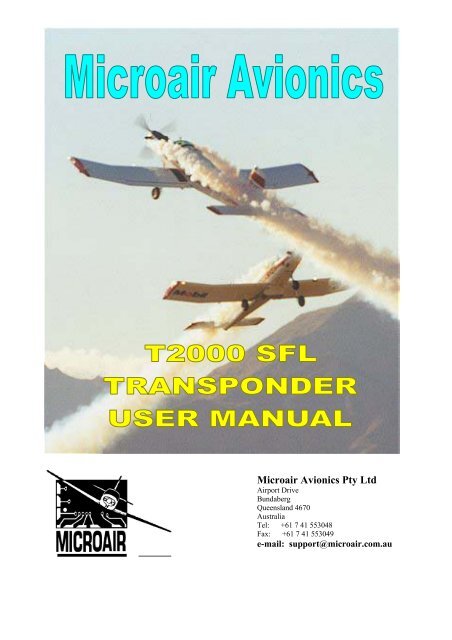
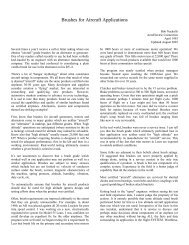
![G-Series-Ext [pdf] - Carling Technologies](https://img.yumpu.com/50918301/1/190x245/g-series-ext-pdf-carling-technologies.jpg?quality=85)
